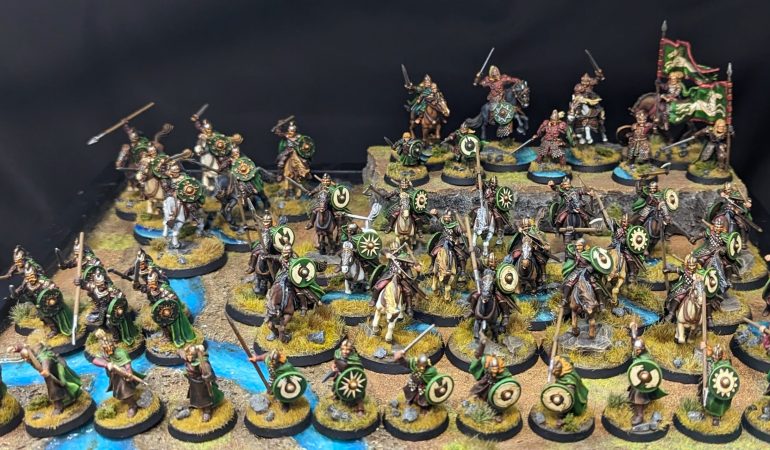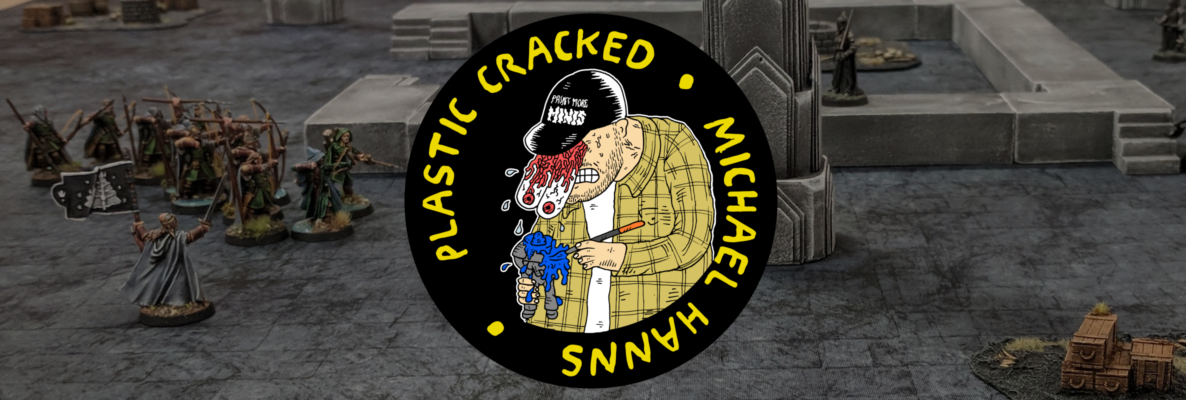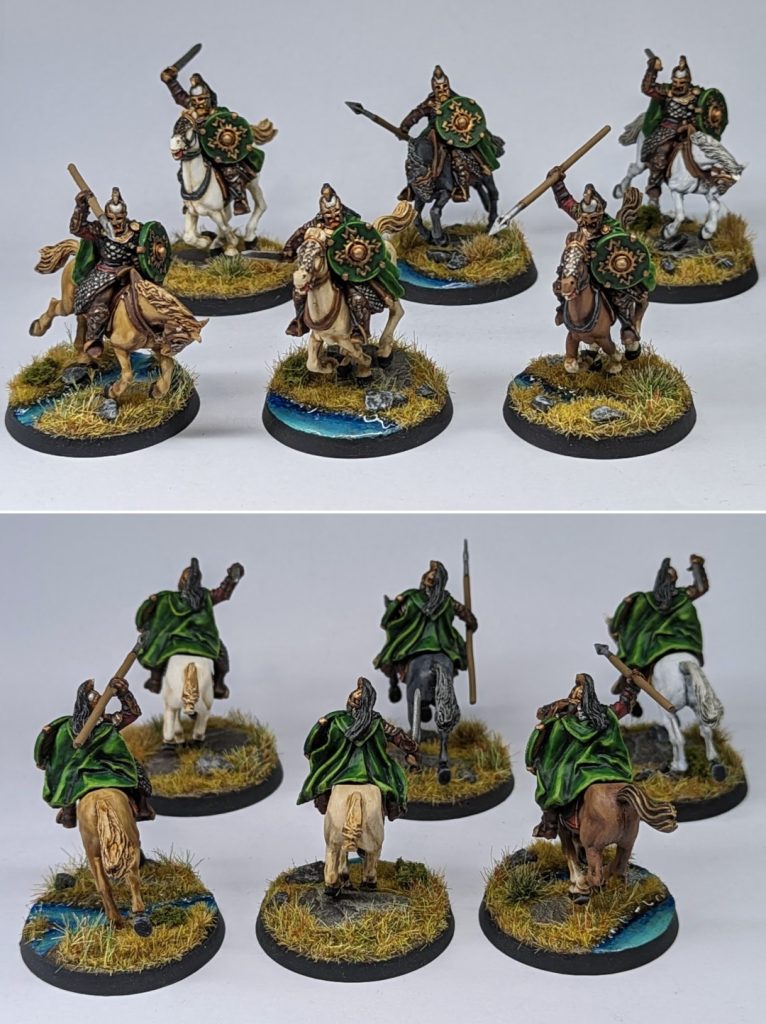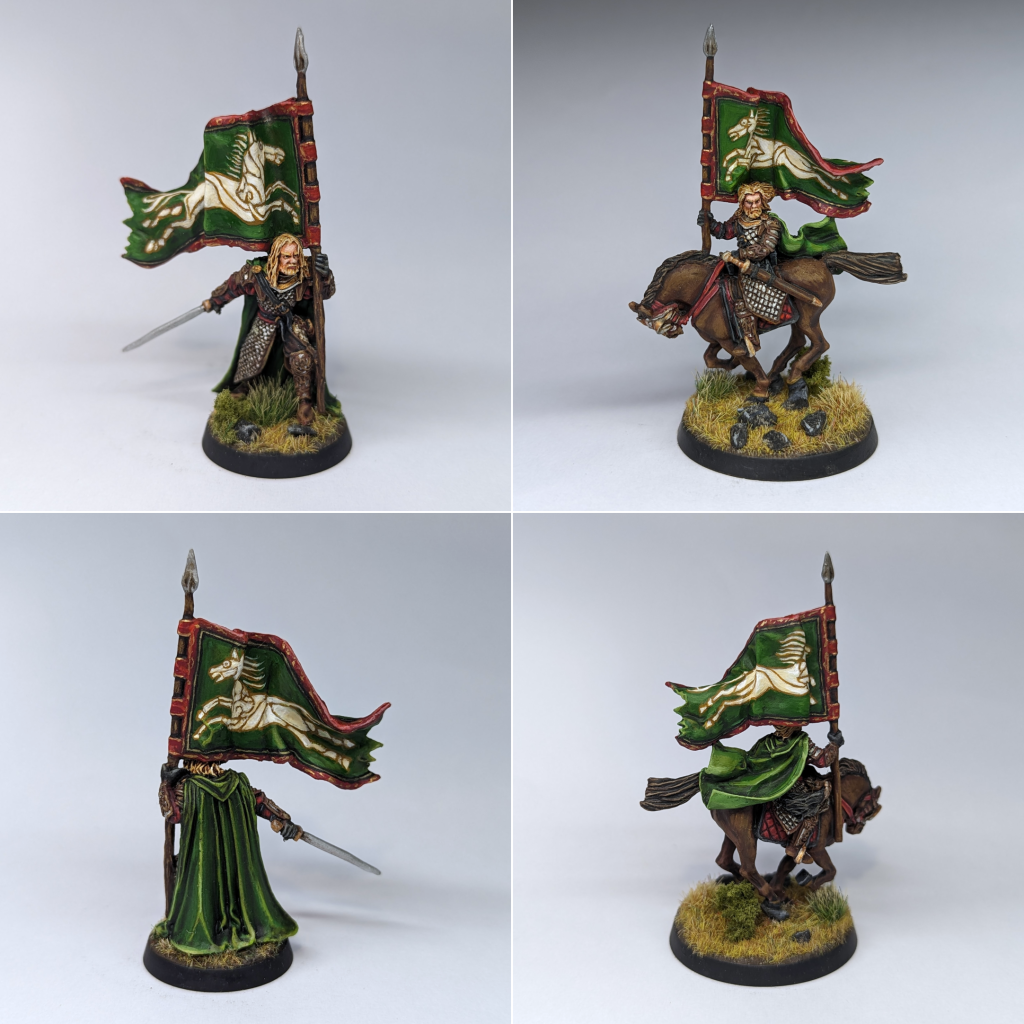
Arise, Riders of Théoden; it’s time for another instalment of ‘Forth, Eörlingas!’. After determining the paint scheme and cranking out 18 Riders of Rohan with 12 dismounts in Part One, we’re now going to cover the elite Warriors and Heroes to finish up my 800pts Riders of Théoden army list. We’ve got a lot to cover here, so let’s dig in!
Kicking off the army is six Royal Guard miniatures, which will make up the dismounts of my Royal Knights.
I have some very mixed feelings on these miniatures. At a glance, they look good. They’ve got a nice silhouette and they’re a faithful reproduction of the Royal Guard from the movies – which is itself a really cool visual design. They still look rugged and functional, as befitting the grim Men of Rohan, but with heavier armour than the standard Warriors of Rohan and a touch more pomp. The horse hair helmets really set them off, as does the leather trimmed plate armour and a flash of gold on the gorget and shields. On the other hand, there is exactly two sculpts for these – both of which are functionally identical but for a head facing left rather than right. The saving grace for these models is that you get the option to equip them with throwing spear or sword and a choice of two slightly different weapon arms which can be glued in subtly different rotations. So, while there’s not a ton of variety, I do find the very subtle A/B poses and slight differences in arm position help keep the miniatures from looking entirely static without any particularly jarring or obvious repetitions (looking at you, that one guy from every plastic kit in a wildly different pose to the rest of the squad).
Due to the limited number of poses available1, I opted to build my six Royal Guards with three throwing spears and three swords. The plan is to equip my whole army with throwing spears, so I’m not too bothered about whether the spears are represented on all of the models. If it’s going to be a serious problem for tournament play, I’ll either stick some spears to the backs of miniatures or just deal with using considerably less of them in my army – but until then, I’m choosing a varied aesthetic over pedantry.
The mounted Royal Knights miniatures share the same list of pros and cons as their dismounted counterparts, although I have three additional little grievances to add to these. The first issue is the price; the mounted miniatures have the exact same metal part count as the Royal Guard minis, but cost over three times the price. Games Workshops pricing scheme has always been a little baffling, but tripling the cost of an already pricy metal miniature for the addition of a generic plastic horse is a tough pill to swallow. Speaking of the horses – my second (and least important) grievance with these miniatures is that the horses are the same ones as on the Riders of Rohan. This is not the end of the world and – given these are old pewter miniatures, I can see why this was the case – but it would’ve been nice to have another, more heavily decorated horse head piece or something, particularly given the aforementioned premium that you pay for these miniatures. Finally, I will say that I was not particularly taken with the casting quality of these miniatures either. All 6 of them needed a little bit of work to straighten out the shields, which were curved and warped out of the pack. This was no easy task when you’re dealing with metal that thick and chunky, made worse by the delicate detail on either side. On my first attempt, I managed to damage the shield with my pliers and had to resculpt some of it afterwards. Not the best when these are supposed to be the flashiest and eye catching Warrior models in the army.
As far as painting the Royal Guard went.. Well, in this regard, I’m kind of pleased that the prohibitive cost of these miniatures had me settling for 6 of them rather than 12. These are immensely frustrating miniatures to paint. The somewhat delicate detail made picking out the scale mail incredibly difficult, but this was nothing compared to trying to paint the leather trimmed plate mail. I’m not sure how clear it is in my photography, but the shoulder pauldrons, boots and gloves of these miniatures have little metallic silver sections in the recesses of the leather armour. To look right, this needs to be adequately shaded in the deep recesses, while the leather itself needs a shade and highlight as well. On these tiny little 25mm non-heroic scaled models, it can be quite difficult to tell how well it’s going with the naked eye and incredibly fiddly.
Armour aside, the rest of the Royal Knight minis were fairly by the book. I painted the horses as normal, though gave them red saddles with gold trim and even added a few additional details such as white socks on one of the horses. The shields and cloaks were good fun to do as per usual and I’m on the whole very happy with how these models turned out. I’m not in a massive hurry paint another six of these, though.
With the Royal Guards finished up, the bulk of the army was now good to go. 18 Riders of Rohan and 6 Royal Guard. Time to smash out of the heroes – the first of which was Théoden.
Speaking of challenging miniatures to paint, I honestly had a bit of a hard time painting Théoden. The miniature itself is a beautiful, crisp sculpt with some nice chunky detailing. After the nightmare of the Royal Guard, I was all ready to paint this miniature until I realised there’s supposed to be gold inlaid between those raised areas.
Perhaps I just made life difficult for myself by insisting on the gold inlays in the armour detail, because this game me a lot of bother. The trouble here is that although the detail is now more pronounced, you still need to paint the ‘sides’ of the raised detail without getting the brown paint on the gold in the recessed area below. This is not as trivial as it sounds on a miniature of this size. Inlay aside however, I found this miniature an absolute delight to paint, at least compared to the Royal Guard. The scales on his armour skirting are so crisp and easy to pick out, the embossed leather on Snowmanes barding is chunky with deep recesses that make it trivial to shade and highlight.
Although I’m reasonably happy with the final outcome on this miniature, if I had one regret with the finished product it’s I wish I’d painted Théoden’s armour with a little more red in the reddish brown. That being said, I think that – particularly among the other heroes painted below – the brown leather really stands out in an army with an abundance of green and helps him to stand out even among the other heroes.
Bar none, my favourite model in this whole army is Eómer. I love the look of the miniature, it was a joy to paint and I’m super pleased with the end result – you can’t do any better than that in my book!
I’ll admit, I was a little skeptical when this miniature was first revealed. While the level of detail was obviously much improved, something about the pose or the way the armour sat on the dismounted version of Eómer made him look kind of short and stocky, almost Dwarf-like. I’m pleased to say that, in person at least, that is absolutely not the case with this miniature. It’s beautifully proportioned and the detail is absolutely glorious. This model has a lot in common with Théoden, featuring the same embossed leather armour – but for whatever reason, I was not experiencing anywhere near the same headaches painting this one. Perhaps it’s the greater contrast between the red the silver that makes it easier to see mistakes, or maybe the miniature itself just has wider, clearer recesses in which to paint the metallics. Either way, the armour turned out much cleaner on this mini than it did on Théoden and the beautiful, ornate detailling on the sculpt really pops as a result.
I’m also really pleased with how his horse turned out. I achieved the freckled look on the horse pretty much entirely by accident – my brush bristles were a little fractured after drybrushing the tail and mane, so I thought to just tap the tips on the fur, concentrating around where I’d normally put highlights on the model. After the first pass, I dipped the brush tip in a lighter grey and repeated the process, once again adding a good few more jabs around the raised areas where I’d normally put highlights. The end result was a nice, textured look that helped give Eómers horse a little unique character compared to the rest of the army. For a first attempt at a technique like this (does this count as stippling?), I’m really pleased with the outcome.
Another miniature I’m thrilled with the final outcome of is Dernhelm, AKA Éowyn and Merry.
A couple minor points of discussion on the models themselves before we get to the paintjob. I love the character of Éowyn and I really wanted to do her miniature justice, but I am generally pretty terrible at painting female faces on Warhammer models – let alone on tiny Middle-earth miniatures. Fortunately, this miniature is not only remarkably dynamic on both foot and horseback, but comes with the option to build Éowyn both helmeted and bare headed. This was a big plus for me and the final result is much better than it would have been otherwise. I’m also a huge fan of how they’ve handled the optional Merry passenger. Where the new Gandalf the White miniature featured a removable Pippin piece, in my opinion, assembling the miniature without Pippin leaves Gandalf sitting uncomfortably far back on Shadowfax. This is mildly irritating as there’s a number of circumstances where you might want to run Gandalf the White on Shadowfax without Pippin (say, in an Eómers Riders list) and the model looks kind of weird without him. For Dernhelm, Games Workshop took an alternative approach and provided a hollowed out Merry piece that glues directly over Éowyns riding arm. This allows Éowyn to be assembled on her own without compromising the miniature, while also allowing for Merry as an optional extra on the saddle. While Merry is a little more cramped on the saddle, I think the miniature largely achieves having him as an optional extra without compromising either assembly option. It’s a big improvement in my eyes. Honestly, I think the only criticism I have about this whole kit is that Éowyn on foots pose – her Witch King killing stab – is incredibly difficult to photograph without running into a bunch of focus issues. This is such a minor gripe, however, and the miniature looks terrific in person.
Painting wise, this was a fairly standard miniature for the Rohan army, so I don’t have much to add that hasn’t been said already. One thing I will add is that it’s absolutely worth painting Merry’s Lothlorien cloak in a slightly different hue of green to Éowyns, otherwise the model can get a little bit confusing – a top tip that I stole from the excellent box art paint job. For Merry’s cloak, I started with a base coat of Turquoise, highlighted with Heavy Bluegrey and shaded with Coellia Greenshade. I’m quite happy with this colour and I’ll definitely be using this recipe on my Elven cloaks going forward.
Finally, we have the one miniature I have been absolutely dreading… Gamling with the Royal Standard of Rohan.
In recent years, I’ve been having a little more of a go at freehand painting. From gold foil filigree on my Witch Hunter Tyrus for Inquisitor, Skaven symbols and big rat heads for my Old World Skaven army and – most recently – big sad beetroots for my Turnip28 force. Freehand painting is challenging and definitely intimidating at first, but it’s also incredibly incredibly rewarding and satisfying from a creative standpoint. It’s a chance to test your brush control and to put some of the skills you’ve been developing on miniatures about understanding colour and lighting into practice. I tell you all of this now because I want you to understand that the idea of freehand painting a banner wasn’t that intimidating to me in and of itself – but this is no ordinary banner. First – and perhaps most frighteningly – it’s not a flat surface. That alone would take this job outside of my comfort zone for freehand painting, but it doesn’t stop there. It’s a double-sided standard – with there’s both a foot and a mounted one to paint, to boot. That means I need to repeat this design four times without it looking too different on each side. The horse itself is no simple outline either – it’s a complicated, segmented design with lots of internal delicate filigree. To make matters worse, the horse itself is white. Seriously though, did I mention I need to do this four times?
It’s safe to say, I was pretty concerned about how well I could pull this one off. This is the kind of ambitious and eye catching miniature that can make or break an army; regardless of the quality of the rest of the army, if I paint a sloppy, amateurish horse then that’s all I’m ever going to see when I field this army on the tabletop. But, on the upside, if it goes well, then it’s a wonderful, eye-catching centrepiece that I that I can flex my chops on.
I’m pleased to say that – for my money, at least – the banner turned out closer to the positive end of this spectrum than the negative. Yeah, some of the horses turned out a little better than others – the front side of Gamling on foot was my first attempt and still probably my best attempt. The more horses I painted, the faster I seemed to be able to produce them, but I will admit the quality definitely dropped the more I repeated the design. Each time, the process became a little less fun and – while my speed certainly increased – I became less laser focussed on the source material that I was copying and more mistakes and imperfections crept in. This is by far the worst part about having to paint the same banner four times. Sure, the first time is a fun exercise, but the more repetitions you do, the more it begins to become a chore and the shorter your patience gets. Eventually, however, you’ve got to draw a line under the miniature and decide when enough is enough. Even the Games Workshop webstore doesn’t have the exact same standard on both their foot and mounted Gamlings after all2.
Nothing highlights your inconsistencies quite like putting pictures of all four attempts side by side next to each other in a grid for a blog post. While I’m generally content to not sweat the small stuff – different filigrees in the centre area, for example – I did notice that my first attempt of the horse on the front side of mounted Gamling3 had some very different front legs. It took me two further attempts to correct this – the first do-over becoming apparent once again after taking a photograph and putting it into frame with the other three freehands. If you’d like to see my slow descent into madness previous two attempts, I’ve uploaded those here and here. Bear witness to my pain, you sadist.
Beyond the banner, what else do I have to say about this miniature? Well, the lead up to the free hand was pleasant enough to paint. Gamling’s face – on the dismount model in particular – is an excellent recreation of Bruce Hopkins’ portrayal of the character in The Two Towers and paints up very nicely. The mounted version – or at least my painting of it – looks somewhat angrier, although I suspect I’d be looking a bit strained too if I was had to heave that massive standard around with one hand. One element that I was actually quite pleased with on this model was that he had a whole metal new metal horse sculpted for him, complete with quilted saddle which I thought was quite nice – although it does make for a very heavy miniature when you combine this with the added weight of the standard; I suspect this was done as a plastic horse would make the model too top heavy. The additional effort on Gamlings steed seems to have come at the expense of Gamling on foot, however, who shares the exact same torso, legs and cloak from the Rohan Royal Guard miniatures with only a new head and set of arms. Kind of jarring to see a Hero miniature essentially kitbashed from a standard Warrior model, but it’s a testament to how versatile these miniatures are that none of this even occurred to me until I started painting.
Well, that just about covers the final items in my 800pts Riders of Théoden list – let’s have a look at the army altogether!

After a year of procrastination and two months of late nights and hard graft, my Riders of Théoden are complete – and I couldn’t be more proud of them! This is an army that I’ve always wanted to do for Middle-earth, but was always too intimidated by the amount of work involved. Turns out, I was right to be afraid; this army was a ton of work and really pushed my abilities to breaking point in places. Regardless, the rewards of hard work are plain to see – some of these miniatures are my best painting effort yet. I’m thrilled with how the army looks together and I can’t wait to expand upon it in the future.
Next up on this blog, we’re going to revisit an older series – Preparing the Narrative Campaign. Because I can’t leave well enough alone, no sooner than I finished this 800pts Matched Play army, I started thinking about how many painted miniatures I now have for the Two Towers leg of the Lord of the Rings narrative campaign. After all, I have some Ents, I have Uruk Scouts, I have Rohan – I’m halfway there, surely? Weeeelll…
After a quick flip through the Two Towers Journey Book and it’s modern counterparts (War in Rohan and the Quest of the Ringbearer), my friend Jack and I decided to make a list of all the miniatures we need to run through the narrative scenarios within and divide up the projects between us. Looks like I’m going to be working on a sizeable Dunland army project in my near future, alongside a good amount of Haradrim and a fair whack more Rohan to boot. It’s going to take over 150 miniatures for my part alone, so prepare yourself for a good bit more Middle-earth content on this blog in 2023!
Before we even get onto that, however, it’s been my intention from the get go with this army to do an 800pts Uglúks Scouts force to go alongside my Rohan. Given the amount of Orcs and Uruk Scouts I already own, I’m hoping this should be a relatively easy win, so keep your eyes peeled for that in the short term.
In the meantime, thanks for reading and happy wargaming!
1 I mean, forget the Royal Guard for a second and take a look at the Riders of Rohan sprue – there are two sensibly posed riders with throwing spears, two riders firing a bow and two with melee weapons. There’s no way I’m going to restrict my whole army to two poses for the sake of wargear choices on the tabletop. WYSIWYG is important if you’re going to mix and match wargear loadouts, but there’s no sense in restricting your miniature choices if you’re taking the upgrade across the board.
2 Looking at the drastically different horse and border designs on the foot and mounted Gamling, I assume these two miniatures were painted by two different miniature painters. This is pure conjecture on my part, however.
3 My second total attempt, so this was my first time trying to paint the horse with the reccessed middle section of the flag – which I will say is considerably harder than the alternative.






